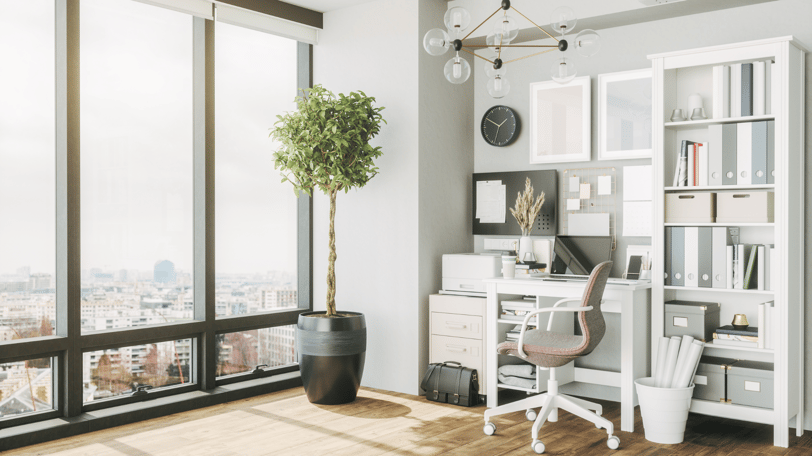How to Choose the Perfect Home Office Chair
An investment in your comfort, productivity, and long-term health.
WORKPLACE BASICS
11/12/2024


Creating a comfortable and productive home office setup starts with choosing the right chair. Whether you’re a remote worker, freelancer, or someone who spends a lot of time at the computer, the chair you choose can impact your comfort, productivity, and even health. Here’s a comprehensive guide to help you find the best chair for your home office.
1. Understand Your Needs and Workspace
Identify how much time you’ll spend in the chair: For example, if you’ll be seated for long periods, consider chairs with more ergonomic features to avoid back and neck pain.
Consider your workspace size: A smaller room may require a compact chair, while larger rooms give you more flexibility for bigger models.
Think about style and decor: If aesthetics are important, find a chair that blends with your room’s decor.
👉 Direct Purchase TRALT Chair on Amazon featuring a 2D headrest, adjustable lumbar support, and breathable fabric available in five colors.
2. Prioritize Ergonomics
Lumbar Support: Proper lumbar support is essential for maintaining the natural curve of your spine and preventing back pain. Look for chairs with adjustable lumbar support or built-in lumbar support features.
Seat Depth and Width: A good seat should allow 2–4 inches between the back of your knees and the edge of the seat. Opt for a seat with adjustable depth if multiple people will use the chair.
Adjustable Armrests: Armrests relieve strain from your shoulders and neck, but they need to be adjustable to fit the height of your desk and typing position.
Recline and Tilt Functions: Sitting in one position for too long can cause discomfort. Reclining and tilting features allow you to lean back and shift positions comfortably.
👉 Direct Purchase Efomao Chair on Amazon featuring lumbar support, a leg rest, and multiple color options.
3. Choose Quality Material and Upholstery
Breathable Mesh: Mesh is breathable, which helps keep you cool and comfortable over long periods. It’s ideal for warmer climates or workspaces without air conditioning.
Leather and Faux Leather: These materials give a professional look and are easy to clean. However, leather can retain heat, which might not be ideal in warmer environments.
Fabric Upholstery: Fabric chairs are comfortable and available in various colors and patterns, although they may be harder to clean and less breathable than mesh or leather.
👉 Direct Purchase GABRYLLY Chair on Amazon featuring an adjustable headrest and armrests, tilt functions, and flip-up arms.
4. Assess Adjustability Features
Seat Height: The seat height should be adjustable to allow your feet to sit flat on the floor with your knees at a 90-degree angle.
Backrest Angle: Chairs with adjustable backrests provide flexibility to change the angle for different tasks or rest.
Adjustable Headrest: If you need extra support for your neck, especially during extended periods, a chair with an adjustable headrest can relieve pressure on your cervical spine.
5. Check for Stability and Mobility
Base and Casters: A stable, five-point base provides optimal balance, while casters allow for easy movement across floors. If you have hardwood floors, choose chairs with rubber-coated casters to avoid scratching.
Swivel: A swivel base helps you reach different areas of your desk without straining your arms or torso, making it a good option for multitasking.
6. Set a Budget
Consider a Long-Term Investment: Investing in a good chair can prevent health issues and reduce the need to replace it frequently.
Budget-Friendly Options: Plenty of affordable chairs offer basic ergonomic features. Focus on finding chairs with adjustable height, lumbar support, and breathable material if you’re on a budget.
Premium Options: High-end chairs like the Herman Miller Aeron or Steelcase Leap are known for their ergonomic design and durability, making them worthwhile investments if you can stretch your budget.
7. Read Reviews and Try Before Buying
User Reviews: Online reviews give you real insights into comfort, durability, and overall value.
Try In-Store or with Free Returns: If possible, try out different models in-store or buy from online retailers that offer free returns.
8. Consider Additional Accessories
Footrests: A footrest can be beneficial for people shorter than average or for desks that are slightly too high.
Seat Cushions and Back Pillows: If your chair doesn’t have built-in lumbar support, adding a cushion or pillow can offer a temporary solution.
Takeaways from EntrepreneurNook
The perfect home office chair supports your body, adapts to your workspace, and helps you stay focused and comfortable throughout the day. By focusing on ergonomics, material quality, adjustability, and style, you can find a chair that meets your needs and fits your home office perfectly.
EntrepreneurNook
Combine minds, ignite ideas.
Contact
© 2024. All rights reserved.
